Key dosing considerations with EXPAREL
EXPAREL is available in two doses: 266 mg (20 mL) and 133 mg (10 mL). To ensure optimal analgesic coverage, the volume should be expanded for larger surgical sites. To attain early analgesic onset, bupivacaine HCl can be administered immediately before EXPAREL or admixed in the same syringe as part of the total expanded volume.
Dosing for infiltration and field blocks with EXPAREL
Local infiltration
For adults, a maximum dose of 266 mg (20 mL) is recommended, based on:
- Size of the surgical site
- Volume required to cover the area
- Individual patient factors that may impact the safety of an amide local anesthetic
For pediatric patients aged 6 to less than 17 years, dosing is weight based: 4 mg/kg (up to a maximum of 266 mg)
Regional analgesia
For interscalene brachial plexus nerve block in adults, the recommended dose is 133 mg (10 mL), based on a study of patients undergoing rotator cuff repair or total shoulder arthroplasty
For adductor canal block in adults, the recommended dose is 133 mg (10 mL) admixed with 50 mg (10 mL) 0.5% bupivacaine HCl, for a total volume of 20 mL, based on a study of patients undergoing total knee arthroplasty
For sciatic nerve block in the popliteal fossa in adults, the recommended dose is 133 mg (10 mL), based on a study of patients undergoing bunionectomy
The 266 mg (20 mL) dose is appropriate for*:
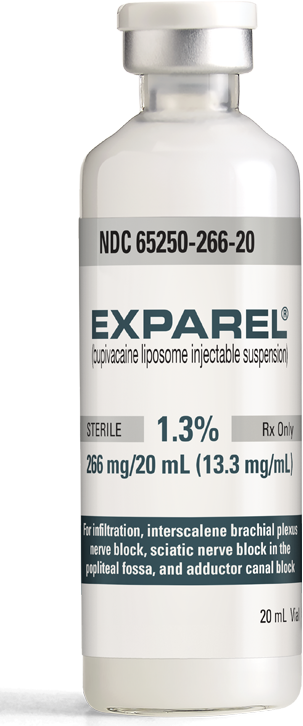
Abdominal/colorectal/general/urologic: abdominal wall reconstruction, bariatric, colectomy, hernia, nephrectomy
Breast: mastectomy, breast reconstruction
OB/GYN: C-section, hysterectomy, myomectomy
Orthopedic: fusions/fractures, THA, TKA
Spinal: discectomy, fusions, laminectomy
Fascial plane blocks: ESP, PECS I and II, QL, rectus sheath, TAP
The 133 mg (10 mL) dose is appropriate for small anatomical areas, such as*:
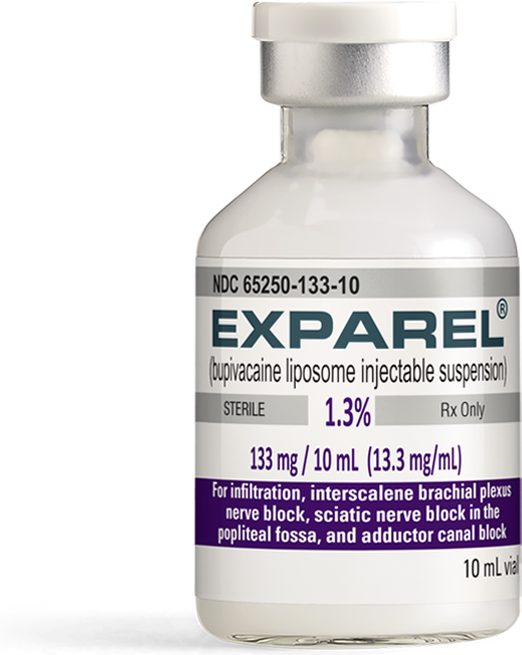
Facial/plastic
Oral/maxillofacial
Upper extremity: interscalene brachial plexus nerve block
Lower extremity: adductor canal block or sciatic nerve block in the popliteal fossa
C-section=cesarean section; ESP=erector spinae plane; OB/GYN=obstetrics/gynecology; PECS=pectoralis; QL=quadratus lumborum; RCR=rotator cuff repair; TAP=transversus abdominis plane; THA=total hip arthroplasty; TKA=total knee arthroplasty; TSA=total shoulder arthroplasty.
*These are examples of procedures that typically require the above-referenced dose of EXPAREL. Please use your professional clinical judgment when determining the appropriate dose of EXPAREL for a given surgical procedure and refer to the full Prescribing Information before using.
Admix EXPAREL with bupivacaine HCl† to ensure early analgesic onset
- Bupivacaine HCl can be administered immediately before EXPAREL or admixed in the same syringe as part of the total expanded volume
- Ensure ratio of milligram dose of bupivacaine HCl to EXPAREL does not exceed 1:2
Admixing bupivacaine HCl with 266 mg (20 mL) of EXPAREL
- 20 mL vial contains 266 mg of EXPAREL, which is equivalent to 300 mg of bupivacaine HCl
- 1:2 ratio allows 150 mg of bupivacaine HCl to 266 mg of EXPAREL

Admixing bupivacaine HCl with 133 mg (10 mL) of EXPAREL
- One 10 mL vial contains 133 mg of EXPAREL, which is equivalent to 150 mg of bupivacaine HCl
- 1:2 ratio allows up to 75 mg of bupivacaine HCI to 133 mg of EXPAREL
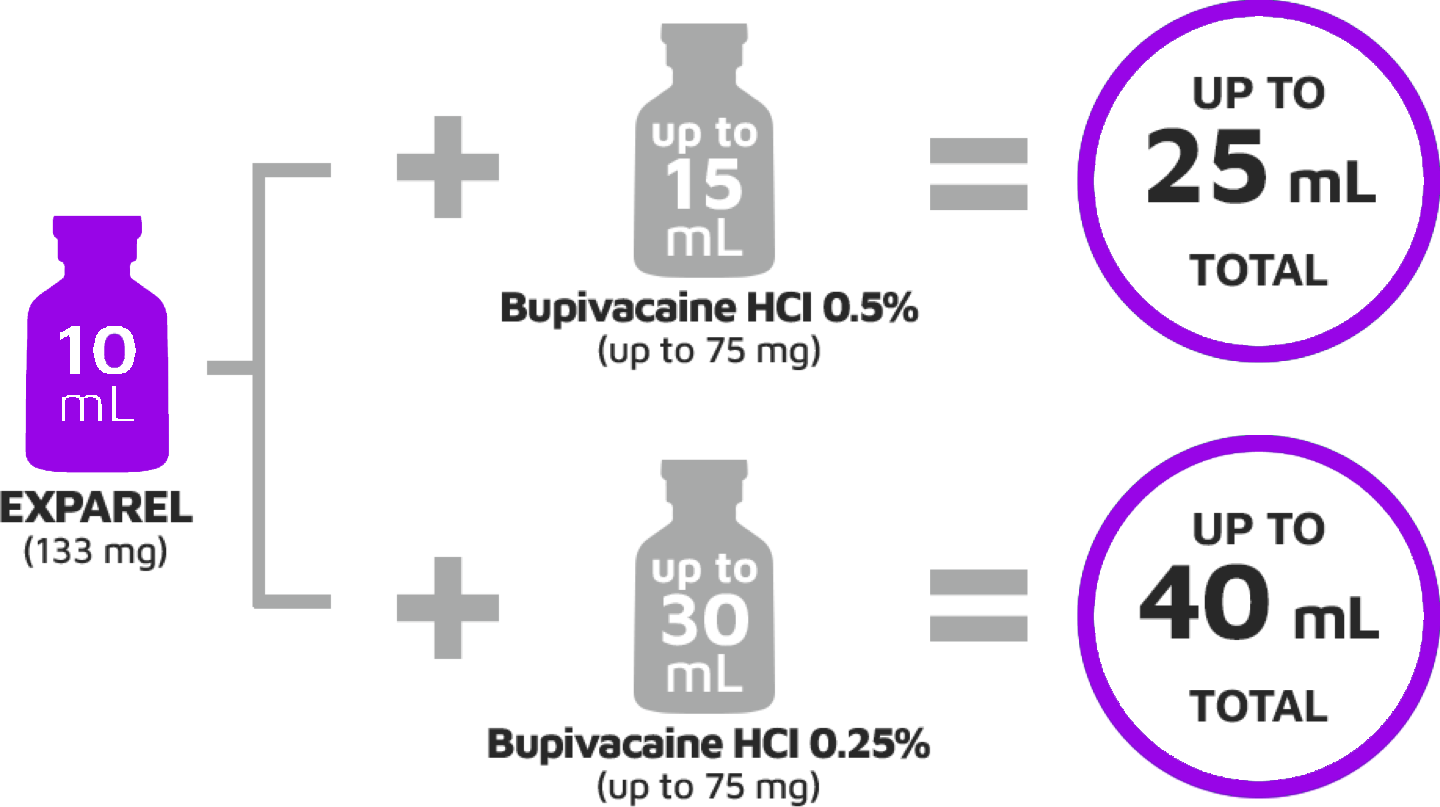
Important considerations for admixing
- Admixing may impact the pharmacokinetic and/or pharmacodynamic properties of EXPAREL; the effect is concentration dependent
- Do not admix EXPAREL with any other agents or local anesthetics (eg, lidocaine) other than bupivacaine
- Avoid additional use of anesthetics within 96 hours following administration of EXPAREL
†Bupivacaine HCl is indicated for use in patients aged 12 years and older.
Expand EXPAREL to ensure optimal analgesic coverage for larger surgical sites
- Sufficient multivesicular liposomes must be available at the pain receptors to continuously release bupivacaine, ensuring long-lasting analgesia
- Consider the size, vascularity, and neuroanatomy of the surgical site
- Expand the volume to disperse liposomes throughout the surgical site
- Use normal saline (0.9%) or lactated Ringer’s solution
- Maintain a minimum concentration of 0.89 mg/mL

EXPAREL unexpanded

EXPAREL expanded
Consider the amount of EXPAREL, bupivacaine HCl,‡ and normal saline or lactated Ringer’s solution as part of the total maximum volume

Compatibility factors
- EXPAREL should not be admixed with local anesthetics other than bupivacaine prior to administration
- Wait 20 minutes after administering lidocaine or other non–bupivacaine-based local anesthetics before administering EXPAREL into the same surgical site
- Allow topical antiseptics to dry before administering EXPAREL into the same surgical site
- Do not dilute EXPAREL with water or other hypotonic agents, as it will result in disruption of the liposomal particles
‡Bupivacaine HCl is indicated for use in patients aged 12 years and older.
Administration guidance for infiltration
Surgical site infiltration
- Use a 25-gauge or larger-bore needle to maintain the structural integrity of the liposomal particles
- Inject slowly and deeply (generally 1-2 mL per injection) into the soft tissues using a moving needle technique (ie, inject while withdrawing the needle)
- Infiltrate above and below the fascia and into the subcutaneous tissue
- Inject frequently in small areas (1-1.5 cm apart) to ensure overlapping analgesic coverage
- Aspirate frequently to minimize the risk of intravascular injection

Fascial plane infiltration for regional field blocks
- Use a regional field block technique, such as ESP, PECS I and II, QL, RS, or TAP, for postsurgical regional analgesia
- Multiple blocks can be used in combination to achieve full coverage of the surgical site(s)
- Perform using ultrasound guidance or laparoscopic visualization to enable precise placement of EXPAREL within the plane
- Deposit EXPAREL within the musculofascial plane so that it can spread and provide sensory blockade to the nerve(s) contained within the anatomical plane
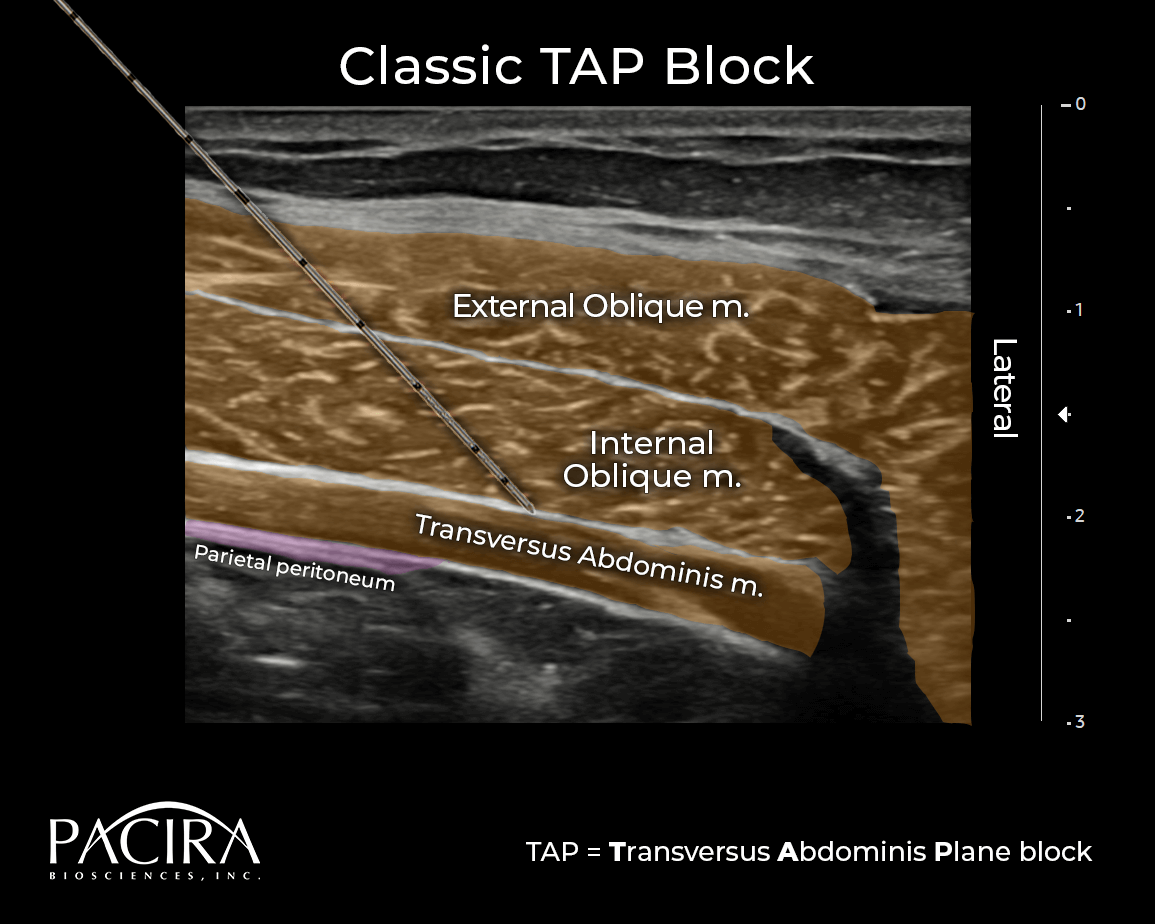
Sonoanatomy showing abdominal wall muscles and the needle direction for the lateral TAP block. The pool of EXPAREL mixture is seen in the correct plane.
ESP=erector spinae plane; PECS=pectoralis; QL=quadratus lumborum; RS=rectus sheath; TAP=transversus abdominis plane.
Administration guidance for interscalene brachial plexus nerve block (ISBPNB) in adults
- The recommended dose of EXPAREL for ISBPNB in adults is 133 mg (10 mL) and is based on a study of patients undergoing either TSA or RCR
- Do not exceed maximum dose of 133 mg (10 mL)
- Administer EXPAREL with a 25-gauge or larger-bore needle to maintain the structural integrity of liposomal bupivacaine particles
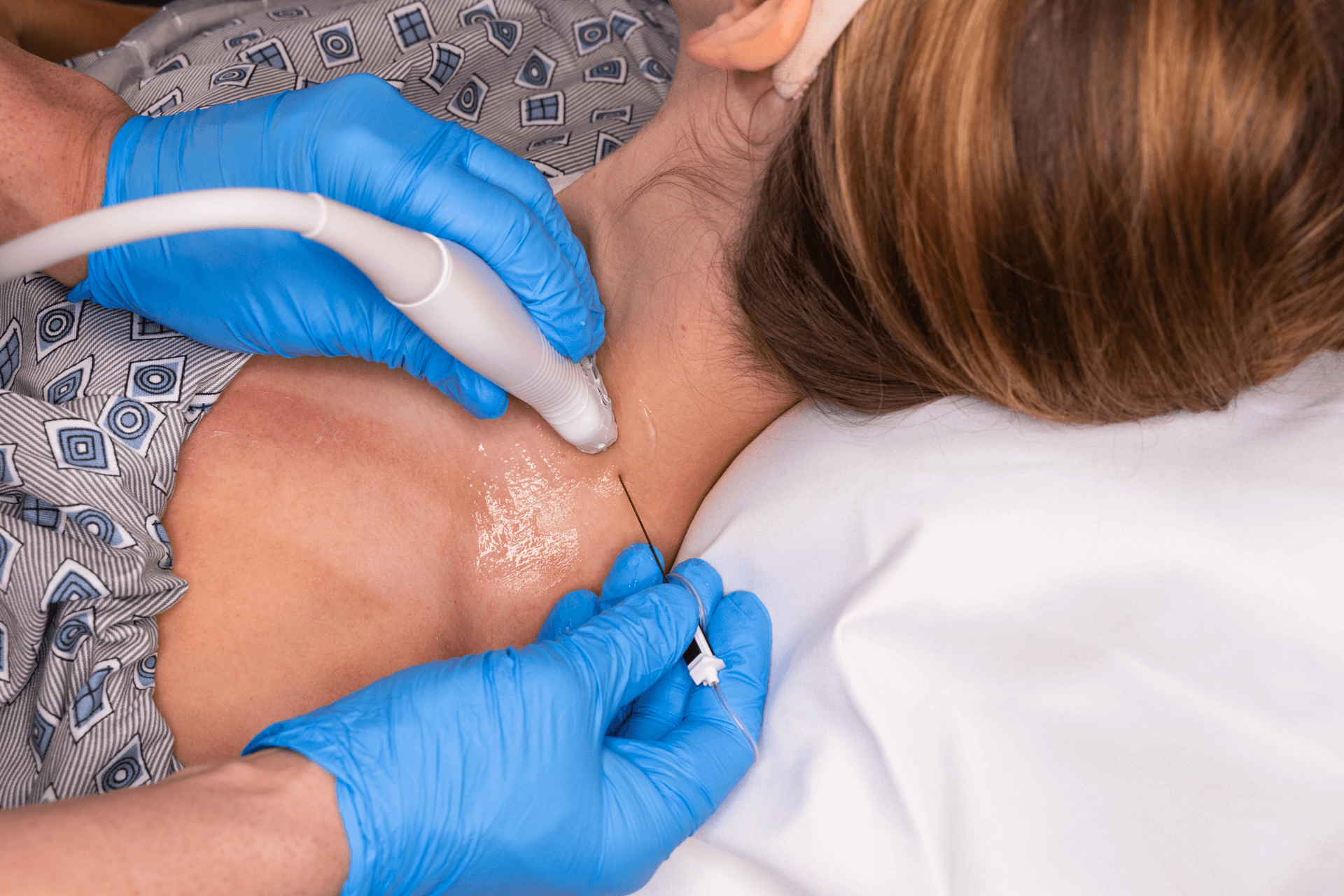
STEP 1: Locate the interscalene brachial plexus
- Place patient in the supine position, with the head of the bed elevated 45 degrees

STEP 2: Visualize the C5 to C7 nerve roots
- Place an ultrasound probe on the patient’s neck superior to the clavicle to identify the interscalene brachial plexus between the anterior and middle scalene muscles

STEP 3: Perform ISBPNB with EXPAREL
- Insert a 20- to 22-gauge echogenic needle into the plane from lateral to medial until the tip is just lateral to the bottom of the interscalene brachial plexus
- Confirm needle position using nerve stimulation and hydrodissection
- Deposit EXPAREL between the anterior and middle scalene muscles until the infiltration around the brachial plexus is documented by ultrasound
ASM=anterior scalene muscle; C5 to C7=cervical nerve roots; DSN=dorsal scapular nerve; LCa=longus capitis muscle; LTN=long thoracic nerve; MSM=middle scalene muscle; RCR=rotator cuff repair; SCM=sternocleidomastoid; TSA=total shoulder arthroplasty; VA=vertebral artery.
Administration guidance for sciatic nerve block in the popliteal fossa in adults
- The recommended dose of EXPAREL for sciatic nerve block in the popliteal fossa in adults is 133 mg (10 mL), expanded with 20 mL of normal saline to a total volume of 30 mL, and is based on a study of patients undergoing bunionectomy
- Do not exceed maximum dose of 133 mg (10 mL)
- Administer EXPAREL with a 25-gauge or larger-bore needle to maintain the structural integrity of liposomal bupivacaine particles
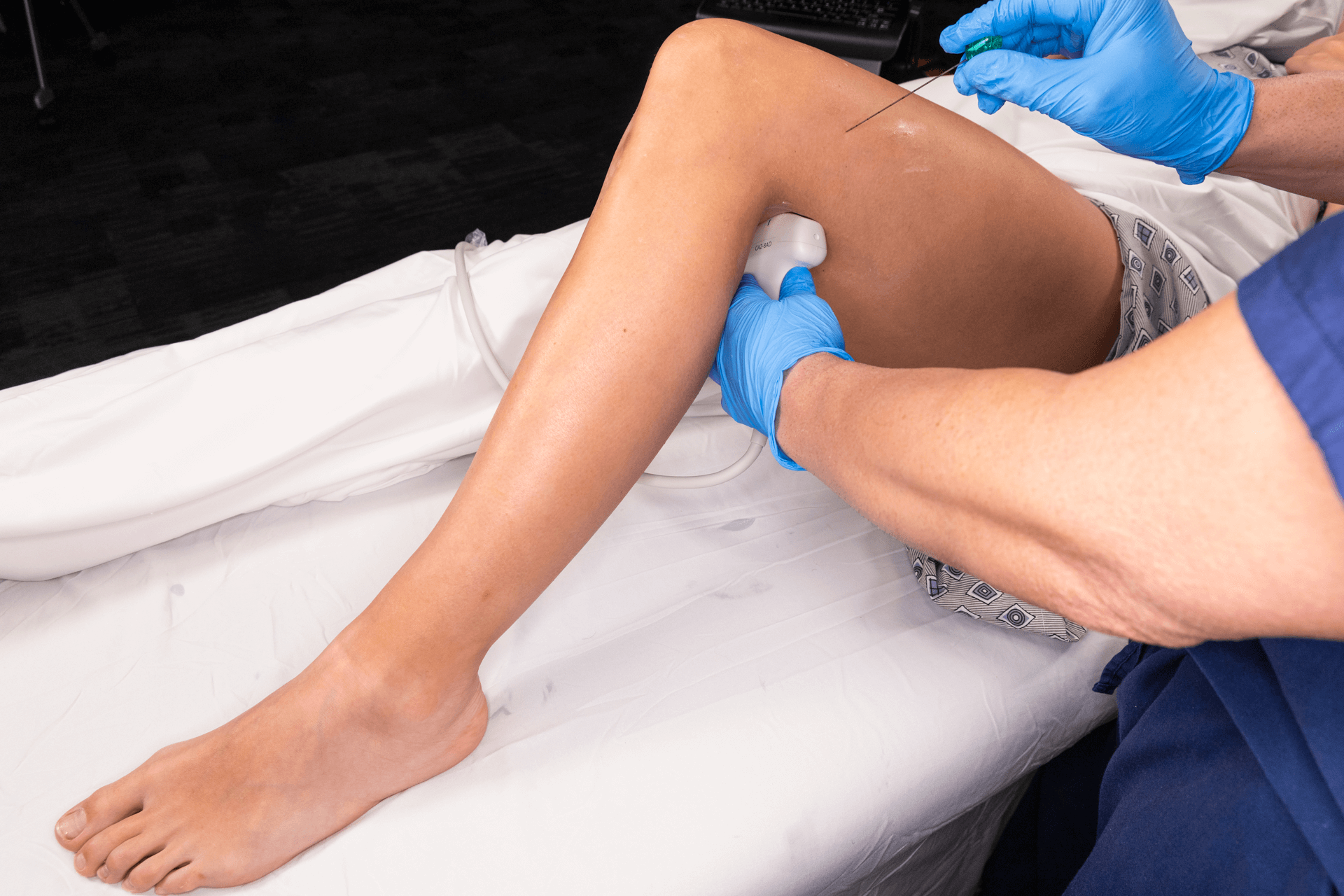
STEP 1: Locate the popliteal fossa
- Place patient in the supine position, with the knee flexed and hip internally rotated to allow access to the posterior thigh and popliteal fossa
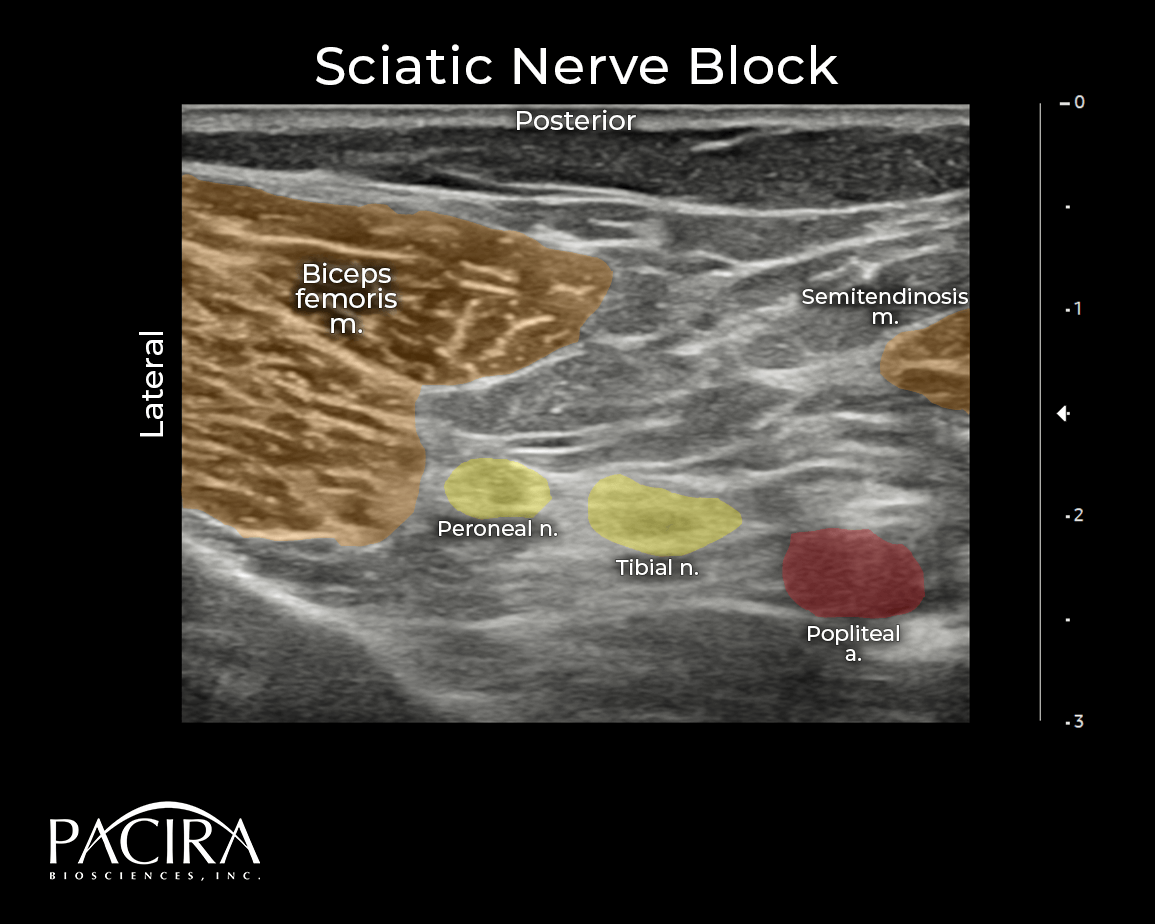
STEP 2: Visualize the TN and CPN
- Use an ultrasound probe to identify the elements just above the popliteal fossa crease
- Move the probe proximally until the bifurcation of the TN and CPN is identified within the sciatic nerve sheath
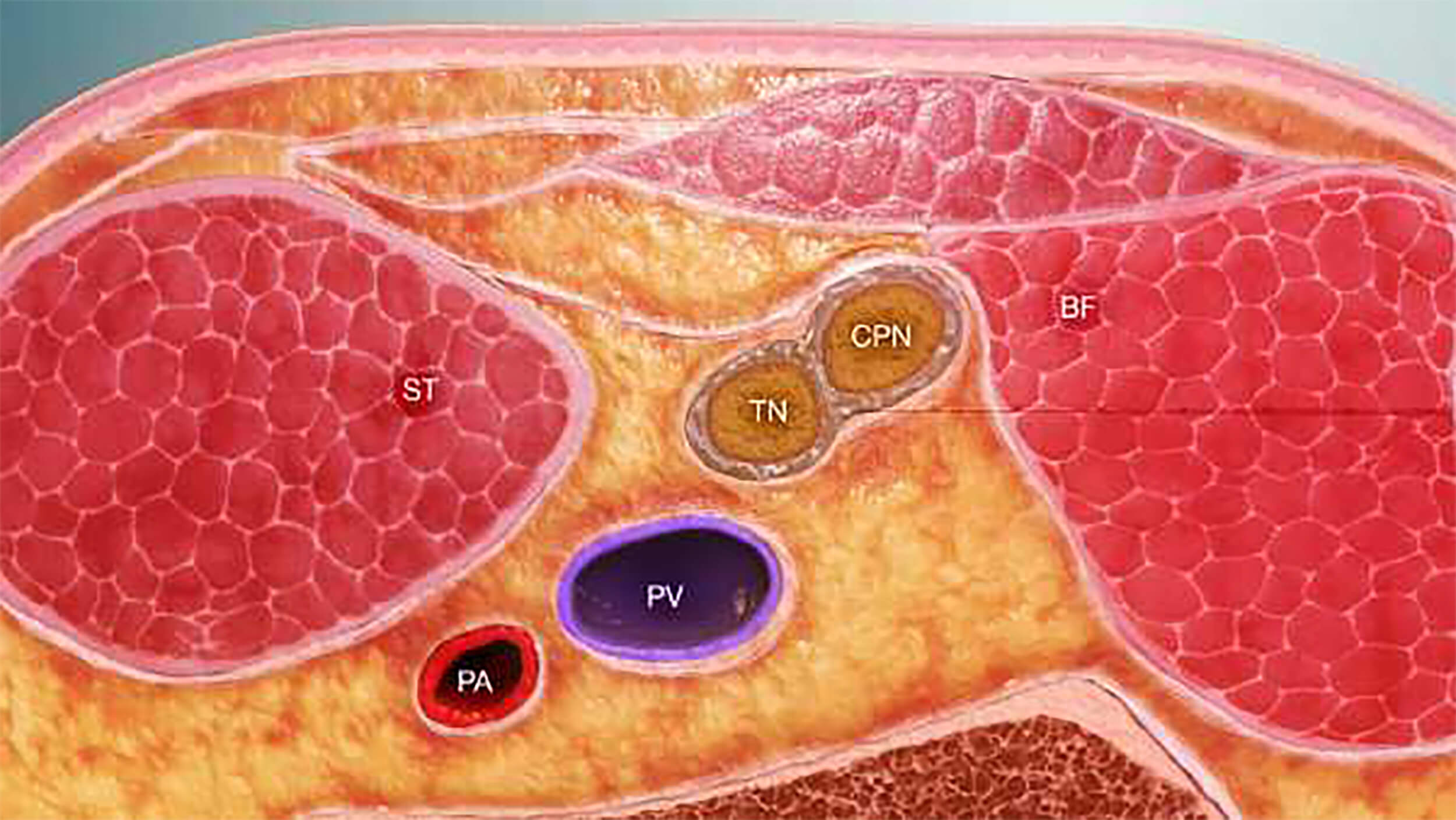
STEP 3: Perform sciatic nerve block in the popliteal fossa with EXPAREL
- Insert a 20- to 22-gauge needle into the plane in a lateral to medial orientation, bypassing the CPN laterally until adjacent to the TN
- Confirm needle position using nerve stimulation and hydrodissection
- Deposit EXPAREL slowly until adequate spread around the TN and CPN is achieved
CPN=common peroneal nerve; TN=tibial nerve.
Administration guidance for adductor canal block in adults
- The recommended dose of EXPAREL for adductor canal block in adults is 133 mg (10 mL) admixed with 50 mg (10 mL) 0.5% bupivacaine HCl,§ for a total volume of 20 mL, and is based on a study of patients undergoing total knee arthroplasty
- Do not exceed maximum dose of 133 mg (10 mL)
- Administer EXPAREL with a 25-gauge or larger-bore needle to maintain the structural integrity of liposomal bupivacaine particles
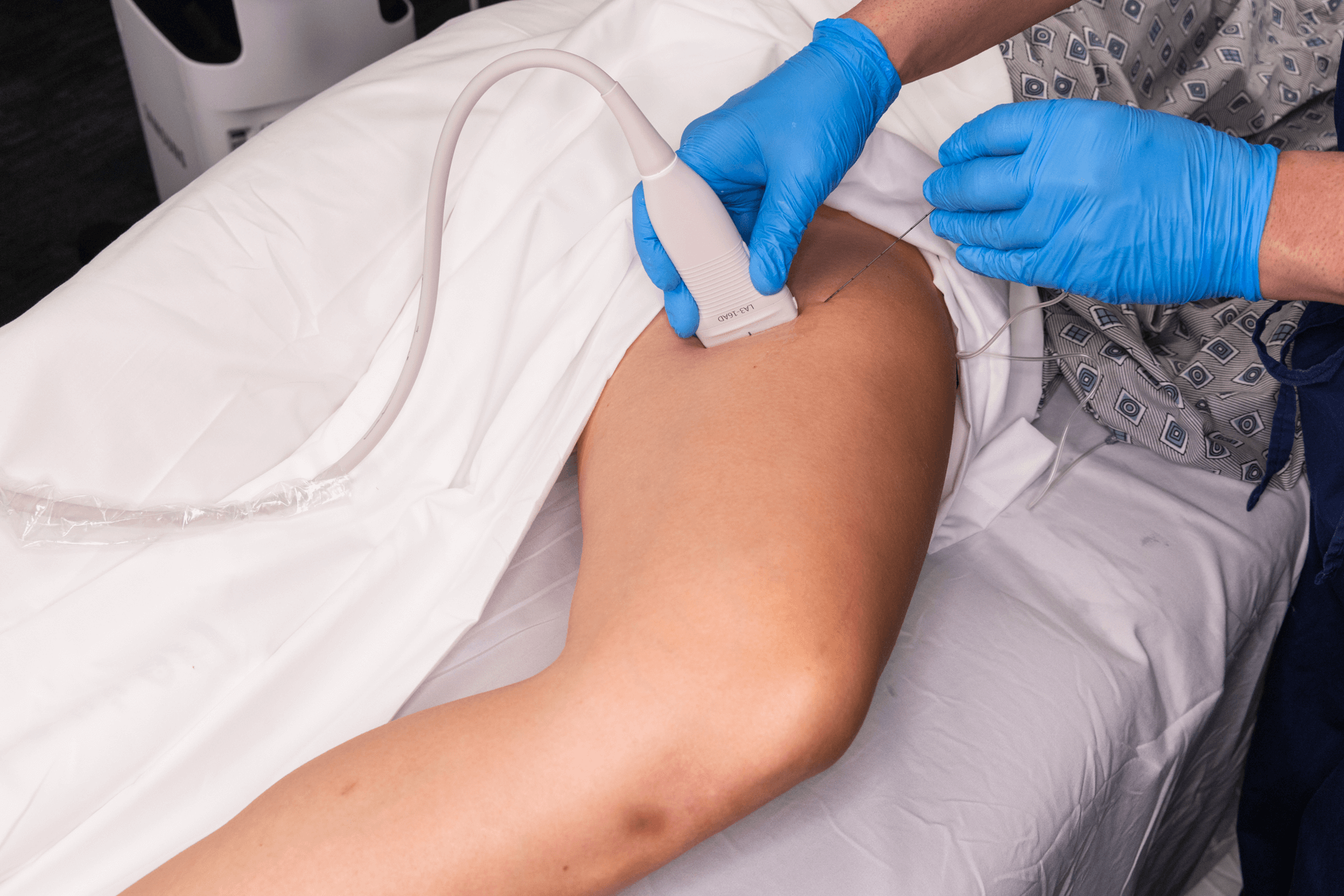
STEP 1: Locate the adductor canal
- Place patient in the supine position, with the hip and knee slightly flexed and the hip externally rotated to allow access to the medial thigh

STEP 2: Visualize the saphenous nerve and NVM
- Use a probe to identify the elements of the sartorius muscle and femoral artery and the vastus medialis allowing visualization of saphenous nerve and NVM

STEP 3: Perform adductor canal block with EXPAREL
- Insert a 20- to 22-gauge needle into the plane in an anterior medial to posterior lateral orientation and advanced toward the NVM
- Confirm needle position using nerve stimulation and hydrodissection
- Slowly deposit 10 mL of the EXPAREL admixture around the NVM until adequate spread is achieved
- Reposition needle to the saphenous nerve, repeating the injection procedure for the remaining 10 mL of EXPAREL admixture
NVM=nerve to vastus medialis.
§Bupivacaine HCl is indicated for use in patients aged 12 years and older.
ASP, average sales price; CMS, Centers for Medicare and Medicaid Services.

